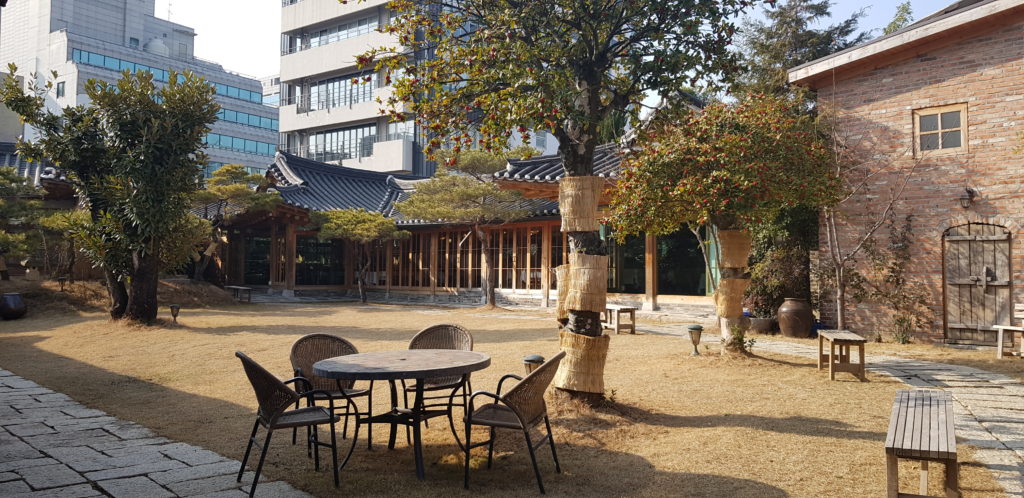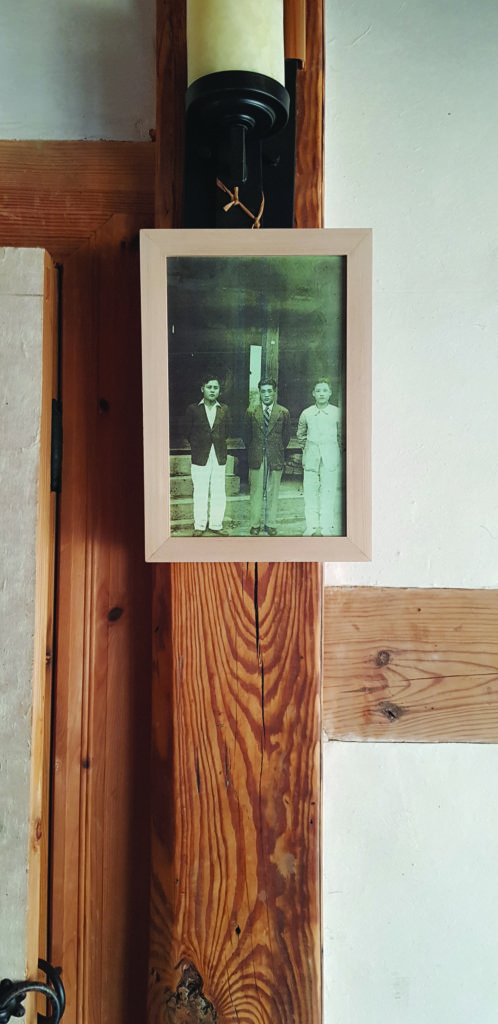Ogaheon: You Can’t Buy History, But You Can Rent It
Originally written by Doug Stuber
(Originally appearing in Gwangju News, #143, January 2014)
This is the second article of a new column in the Gwangju News, Blast from the Past, in which we reintroduce to our readers select articles from past issues that, in addition to being high quality, relevant, and interesting, also provide useful information. We hope you enjoy the column. — Eds.
What if you were walking in the diverse, multi-use neighborhood behind Lotte Department Store: a place with great restaurants, the best in hair care, a cultural non-profit institution funded by Bohae Soju, and even Daein Market? And if on this stroll you came across a walled estate, replete with trees 300 to 600 years old and a broad courtyard, but also with a sadly dilapidated brick house remotely shaped like a traditional Korean hanok, what would you do?

Most would have walked right by on their desired errand, but not the curious, elegant Oh Ok-sun (오옥순). This Gwangju native, who has spent many years living in Seoul, returned here on a trip, fell in love with the urban site, and bought it. Few have ever had such lucky instincts. The rest is already a legend in historical architectural restoration circles.
After purchasing the land and the shabby brick building, but before tearing it down, Oh meticulously knocked out one brick at a time to see what was underneath. Perhaps the cross beams and interior floors were a clue, but she had no idea how impressive the treasure was when she fell in love with the space.

The brick house had been built directly over an 1860 hanok (the L-shaped wooden structures that remain much sought after in Korea, since few survived the wars) and is now back to its original glory, and beyond that, thanks to Oh’s determined commitment. Remodeling took from 2009 to 2012 to complete.
The dwelling was originally built by an iron-industry owner named Choi Won-taek, who entertained early Korean movie stars, and notably, the 1936 Olympic gold-medal winner in the marathon, Sohn Kee-chung (송기정). Sohn’s fame continues because, when given flowers after his triumph, he hid the Japanese flag on his uniform with them, in defiance of Japan’s colonial rule at the time. Sohn visited Choi’s mansion in 1938.

“Three families over seven generations have owned this hanok,” Oh said. Housed in the structure are her own collections that have taken decades to amass, including coffee grinders, brass bowls, tea sets, and the hardware needed to continue ancient traditions like drying persimmons.
In the wrong hands, such a prize might not have ever been more than a dwelling with an old wooden interior. It has now been converted, restored, and augmented with four additional structures of exact architectural resemblance. These make a perfect setting for magnificent weddings, large meetings, receptions of the finest type, or to leave modern stresses behind with a simple afternoon tea.

Courtyard gardens, traditional rice-paper walls and doors, and gleaming freshly varnished wood invite visitors to take calm reflection or partake in one’s natural creative urges, be it calligraphy, painting, or poetry. Completely stocked with antiques, this sanctuary is also fitted with two modern kitchens and contemporary bathrooms. It also gives newlyweds a chance to drift far into the past, while pondering the future as the hanbok-attired day, surrounded by family and friends, becomes a moonlit night in a personal palace.
This Korean bed-and-breakfast, now known as Ogaheon (오가헌, House of Five Beauties: buildings, trees, food, music, and clothes), is fastidiously complete with all the items needed to continue old-style crafts: rolls of dyed cloth waiting to be tailored, flowers to be arranged, and vegetables to be made into salads.
Photographs by Karina Prananto.
Updating of text by David Shaffer.
OGAHEON / 오가헌
Address: 194–24 Guseong-ro, Dong-gu, Gwangju
광주광역시 동구 구성로 194–24
Directions: Take bus number 58, 74, 98, 151, or 419, and get off at the Art Street entrance (예술의 거리 입구) bus stop. Alternatively, take the subway to Geumnam-ro 4-ga, go out exit 4, and walk towards Art Street. Turn left at the first alley past Wongak-sa (temple). Walk straight about 50 meters. Ogaheon is located on the left, behind the Wongak-sa complex.
Phone: 062-227-5557 Website: https://ogaheon.com/
The Author
Doug Stuber is a retired Chonnam University professor, artist, musician, and poet. His twelveth book of poetry, Chronic Observer, will appear from Finishing Line Press in February.





